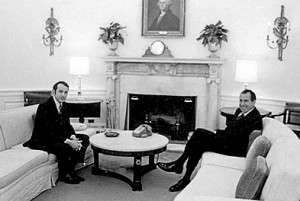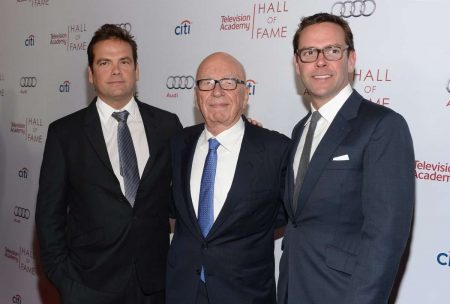Television and I grew up together.
— Roger Ailes, 1995 (13)
Among the sheer glut of head-spinning headline-grabbing news stories emanating from the American political culture this spring, one arrived with far less fanfare than it deserved: former Fox News chairman and CEO, Roger Ailes, died on 18 May 2017. A lifelong sufferer of hemophilia, he fell and hit his head at his Palm Beach, Florida home on May 10 and eventually succumbed to severe bleeding.
CNN Breaking News: Former Fox News Chief Roger Ailes Dead at 77, 18 May 2017
https://youtube.com/watch?v=CEZrdKlokHQ
News reporters, TV’s talking heads, and social media junkies did acknowledge Ailes passing, but competing for attention with the latest developments from the Trump administration as it galumphed its way towards 119 days and counting was no easy task. With so many current crisis and challenges—Russia, Syria, North Korea, Washington gridlock, the latest terrorist attacks, an impending overseas presidential trip to the Middle East and Europe—it’s small wonder that Roger Ailes was treated as somewhat of an afterthought. Since the launch of the Fox News Channel on 7 October 1996, Ailes has arguably been as important and influential in American media and politics as anyone. Granted he wasn’t as up close and personal to the viewing public as those he most opposed—notably Bill and Hillary Clinton and Barack Obama—and those he championed—George W. Bush and Donald Trump, among others. He was instead the consummate behind-the-scenes operator, but still very much in the arena. In fact, a case could be made that he occasionally set and often affected the arena’s ever-changing news agenda. In the end, Ailes was forced to experience the kind of mediated feeding frenzy that he had conjured up and wreaked on his political opponents so many times before throughout his long and successful career as a culture warrior. As a result, he was forced to resign by his bosses—News Corporation media mogul and longtime patron, Rupert Murdoch, and his sons, Lachlan and James—in the face of nearly 50 claims of sexual harassment and related predatory behavior, which he continued to deny up unto his death, even though former Fox commentator, Gretchen Carlson, had a taped recording of him propositioning her.
PBS Newshour: Fox News Ends Ailes Era with Apology and $20 Million for Gretchen Carlson, 6 September July 2016
Once Ailes left Fox with a $40 million severance package, but shackled with ironclad noncompete and confidentiality provisions, he instantly became a figure of history. Born on 15 May 1940 in small town, Warren, Ohio, a stones throw from hard-scrabble Youngstown, he grew up in a blue-collar household with an abusive father who his mother divorced during Roger’s college years. He majored in radio-television at Ohio University and worked his way up from student intern to executive producer on the one-time Cleveland-based soon-to-be nationally syndicated, The Mike Douglas Show (1961-81).
This daytime talk-variety program is where Ailes first met Richard Nixon who was a guest campaigning for president in 1967. At the behest of White House chief of staff, H.R. Haldeman, Nixon eventually hired Ailes away as his television advisor the following year. In turn, Ailes’ career as a media consultant and political operative was launched at the ripe old age of 28. Over the next half century, Ailes would creatively mix the strategies and tactics of entertainment and politics as skillfully as anyone of his generation.
Some of Roger Ailes’ greatest hits as a political consultant include the not insignificant feat of softening and humanizing Richard Nixon’s mediated image (see Joe McGinniss’ The Selling of the President 1968); engineering Ronald Reagan’s 1984 landslide reelection victory over Walter Mondale; overcoming George H.W. Bush’s ‘wimp factor’ by flipping this perception onto Michael Dukakis in 1988 (see his tank ad below); president of CNBC (1993-95) where he also created the ‘America’s Talking’ channel, which ironically morphed into MSNBC on 15 July 1996; and visionary leader of the one-time upstart Fox News Channel, which passed CNN as the number one source in cable-and-satellite news beginning in January 2002 and remaining unchallenged in the top spot for the rest of Ailes’s reign as network chief.
1988 Bush Election Ad by Roger Ailes: Michael Dukakis in an Army Tank
Roger Ailes is the person most responsible for updating political programming for the Cable-and-Satellite Era. Fox News was much more than a ratings powerhouse. It grew to be the go-to source for conservative politics in the United States, and over the long haul, internationally. As of Ailes departure in the mid-summer of 2016, Fox News was then available throughout Africa and the Middle East as well as in 59 other countries (i.e., Argentina, Australia, Bahamas, Bolivia, Brazil, British Virgin Islands, Cambodia, Canada, Chile, Columbia, Costa Rica, Dominican Republic, Ecuador, El Salvador, France, Greece, Grenada, Guatemala, Honduras, Hong Kong and Macau [autonomous regions of the People’s Republic of China], Iceland, Indonesia, Israel, Italy, Jamaica, Japan, Kazakhstan, Korea, Latvia, Maldives, Marshall Islands, Mexico, Monaco, Mongolia, Monte Carlo, Myanmar, The Netherlands, New Zealand, Nigeria, Palau, Panama, Papua New Guinea, Paraguay, Peru, Philippines, Portugal, Russia, Singapore, Slovenia, St. Kitts, St. Lucia, St. Maarten, Taiwan, Thailand, Trinidad, United Kingdom, Uruguay, Venezuela, and Vietnam). Content originating from the Fox News Channel and its international affiliates has been a major contributor to the global news cycle throughout the 21st century.
In addition, Roger Ailes should not be underestimated as a strategic thinker. While working for Nixon and Haldeman in 1970, he penned a white paper entitled, ‘A Plan for Putting the GOP [Republican Party] on TV News,’ which was a rudimentary blueprint for what would become the Fox News Channel a quarter-century later. Ailes first foray into enacting this idea was with the short-lived (1974-75) right-wing news service, Television News Incorporated (TVN), which was bankrolled by the conservative beer magnate, Joseph Coors. TVN was where Ailes first created the branding line, ‘fair and balanced.’
What set Roger Ailes apart was his prescient understanding of television branding. When CNN (Cable News Network) was founded as the first all-news channel in 1980, it was merely a utility brand according to the parlance of the TV business. The limitation of utility branding is that this kind of marketing is much too easy to copy. CNN’s parent, Turner Broadcasting, and the entire industry soon learned that fact in 1983 when Westinghouse and ABC started the short-lived Satellite News Channel, followed in 1996 by Fox News and MSNBC.
Utility brands only establish a functional relationship with audiences—for example, providing news all-day everyday—whereby other channels can come along and either duplicate or even exceed the kind and quality of service provided by the original network. What Ailes pioneered in cable news was identity branding with an aggressively conservative take on current events. Unlike utility branding, this more sophisticated approach is designed to tap into what a specific target audience really cares about, thus forging an emotional bond well beyond any content category such as news.
Roger Ailes’ insight and Rupert Murdoch’s financial gamble was that narrowcasting meant more than an eye-catching network logo, a handful of popular programs, and a destination for as wide a swath of news junkies as possible. Instead, Fox News aspired to forge a deep and lasting relational bond with its core conservative viewership: ‘We report. You decide’! ‘Fair and balanced’ was understood by Fox’s target audience as delivering a long overdue corrective to the inherently biased, dishonest, and self-serving liberal mainstream news media.
Viewed through this self-selecting aperture, Fox News quickly surpassed talk radio’s The Rush Limbaugh Show (1992-present) as the most influential conservative forum in America and has remained on that lofty perch for the intervening two decades. Roger Ailes adapted the take-no-prisoners tactics to the news business that he had refined through trial-and-error against first Hubert Humphrey in 1968, then Walter Mondale in 1984, and finally Michael Dukakis in 1998. Likewise, he rebranded his latest political opponent, CNN, the ‘Clinton News Network’ in 1996. Fox viewers loved his irreverent hutzpah, while CNN’s leadership didn’t know what hit them.
Employing an addictive witches brew of rumors, accusations, and innuendos, Ailes built up Fox News’ viewer base in the late 1990s by providing wall-to-wall coverage of the Monica Lewinsky scandal and the subsequent Clinton impeachment proceedings. Ailes’s brand of grievance politics was now far more out in the open than it ever had been in the days when his initial political mentor, Richard Nixon, was president. For two decades, the moral shortcomings of the Clintons has been Fox News’ one constant, followed in short order by suspicions about American Muslims, questions about Barack Obama’s birthplace, the overreach of Obamacare, the secularist war on Christmas, and the reverse racism of the Black Lives Matter movement. Fox News also pushes back hard on news stories that originate from other journalistic sources, but are critical of Republicans, such as the ongoing Trump-Russia probe.
Message Discipline from Fox News: Pushing Back on the Trump-Russia Connection
Under Roger Ailes, the Fox News Channel imposed a kind of ideological discipline that regularly exceeded the message discipline of the Republican Party. During the Obama years, moreover, Roger Ailes’ worldview grew increasingly strident, always combative, and occasionally bordering on reactionary. Like Nixon, his enemies were the elites, the cosmopolitans, and the overeducated. In 2015 and 2016, Ailes and company often functioned as an arm of the Trump campaign, turning a Democratic centrist like Hillary Clinton into a present-day caricature of Lady Macbeth. Roger Ailes may not have been the kingmaker, as a few commentators on both the left and right have claimed, but he and Fox News played a major role in creating the polarized conditions that allowed an angry populist candidate like Trump to thrive.
Media Matters: How Fox News Built Donald Trump’s Presidential Campaign
Ailes ouster—some three and a half months before the November 8 election day—set off a chain of events that eventually led to Bill O’Reilly’s summary dismissal on 19 April 2017 for his own catalog of sexual harassment allegations and subsequent network payoffs; the May 1 removal of co-president and longtime Ailes’ lieutenant, Bill Shine, for turning a blind’s eye to the channel’s old-school sexist and racist work environment; and the May 19 no tolerance firing of host and commentator, Bob Beckel, for making prejudiced remarks towards an African-American co-worker. Speculation now centers on Sean Hannity’s tenuous future at Fox News for spinning one conspiracy theory too many as well as the long-term fate of the entire Fox News enterprise in the wake of Roger Ailes’ passing.
Fox News’ world has been turned upside down in less than a year. The money-making juggernaut that averaged revenues exceeding $2 billion and profits of nearly $1 billion a year as recently as the early to mid 2010s is now under siege by its longtime sponsor base. The straw that broke the camel’s back is the string of embarrassing scandals and miscues over the past 11 months, but the underlying structural problems at the Fox News Channel are far more deep-seated and terminal, warranting a dead reckoning or immediate assessment of the prevailing state of affairs at the network.
To borrow a metaphor, a dead or deductive reckoning is a technique that dates back to the 17th century whereby sailors and later aviators in the 20th century pinpointed their current position by taking into account the distance and direction they had just traveled, allowing them to make snap judgments about what prospects they faced and what may be the best way forward. To add an analogy, the Fox News empire was so dominant in the cable-and-satellite news sector under Roger Ailes since 2002 that it fell into the kind of trap that IBM experienced in the computer industry in the 1990s; General Motors in the automobile industry in the 2000s; and Microsoft in the software industry in the 2010s. They rested on their laurels and found themselves no longer on the cutting edge of their respective markets, which in themselves were evolving at breakneck speed.
When Roger Ailes worked for Richard Nixon, his charge was to activate what was then a silent majority of Americans to vote. In contrast, Fox News’s target audience in 2017 is an ever- shrinking highly vocal outsized minority. Consider the channel’s current viewer demographics comprise a median age of 70 that is 92% white (and 1.1% black), 57% male, and self-identifies as 66% conservative. In contrast, the average viewer for both CNN and MSNBC is nearly 10 years younger, much more multicultural (14% and 25% black, respectively), closer to 50% male (news as a genre still skews towards men), and much less partisan (although MSNBC does tilt liberal). Even a cursory look at these numbers suggest that Fox News’ core constituency is not only decreasing (as is the case for all cable-and-satellite news programming), but it is rapidly dying out.
With the loss of its guiding light, Roger Ailes, and the key members of his leadership team, along with many of its biggest stars (Bill O’Reilly, Megan Kelly’s defection to NBC News in January 2017, and the abrupt replacement of Greta Van Sustern at the channel in September 2016 and her reemergence on MSNBC on 9 January 2017), Fox News’ primetime lineup is now solely comprised of older middle-aged white men, directly mirroring its core audience. As has been the case since the inception of the network as well, the women hosts and commentators at Fox News all sport the throwback sexed-up blonde Hollywood look more reflective of the Mad Men–Fifties and Sixties, only this time without the irony of Matt Weiner’s series.
Suffice it to say that it is small wonder that 86-year-old Rupert Murdoch’s sons, 45-year-old Lachlan, executive co-chairman of the News Corporation and 21st Century Fox, and 44-year-old James, CEO of 21st Century Fox, are already planning a shift to a less partisan posture for the entire Fox News empire. May 2017 marked the first month where MSNBC actually beat both CNN (second) and Fox News (third) in the primetime ratings for cable-and-satellite news in the United States. Whether or not these rankings signal a momentary hiccup for the Murdoch property, all indications are that a major reboot at the network is in the offing. ‘CNN is again becoming the model for Murdoch’s sons, Lachlan and James, as they envision a post-Ailes world’ (Wolff). When compared to the Russian web-based social-mediated propaganda machine of 2017, the Fox News Channel of today appears downright quaint. Roger Ailes is also a product of a bygone era. Like him, his legacy and brand of media and politics are passé albeit experiencing one last hurrah before they too are relegated to the ash heap of history.
Works Cited
Ailes, Roger, with Jon Kraushar. You Are the Message: Getting What You Want by Being Who You Are. New York: Crown Business, 1995.
McGinniss, Joe. The Selling of the President 1968. New York: Simon & Schuster, 1969.
Wolff, Michael. ‘The Murdoch Father-Sons Feud Over Fox News Post-Roger Ailes’ Hollywood Reporter. 17 August 2016 at http://www.hollywoodreporter.com/news/michael-wolff-murdoch-father-sons-919809.
Gary R. Edgerton is Professor and Dean of the College of Communication at Butler University. He has published twelve books and more than eighty-five essays on a variety of television, film and culture topics in a wide assortment of books, scholarly journals, and encyclopedias. He also coedits the Journal of Popular Film and Television.








